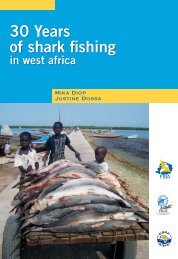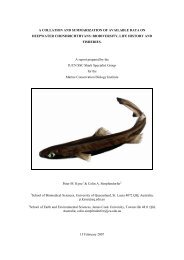Magazine of the species survival Commission specialist Group - IUCN
Magazine of the species survival Commission specialist Group - IUCN
Magazine of the species survival Commission specialist Group - IUCN
You also want an ePaper? Increase the reach of your titles
YUMPU automatically turns print PDFs into web optimized ePapers that Google loves.
<strong>specialist</strong> group exchange<br />
streng<strong>the</strong>ned measures are taken to<br />
conserve <strong>the</strong> <strong>species</strong> and its habitat in<br />
<strong>the</strong> future.<br />
For more information on <strong>the</strong> Asian<br />
Wild Cattle SG, please visit<br />
www.asianwildcattle.org.<br />
James Burton<br />
Chair, Asian Wild Cattle Specialist <strong>Group</strong><br />
Bison SG –<br />
European section<br />
An update on <strong>the</strong> European Bison<br />
Conservation Centre (EBCC)<br />
Saola (Pseudoryx nghetinhensis). © Bolikhamxay Provincial Conservation Unit<br />
reached Lao authorities, <strong>the</strong><br />
Bolikhamxay Provincial Agriculture and<br />
Forestry Office immediately sent a<br />
technical team, advised by <strong>the</strong> <strong>IUCN</strong><br />
Saola Working <strong>Group</strong> and <strong>the</strong> Lao<br />
Programme <strong>of</strong> <strong>the</strong> Wildlife Conservation<br />
Society (WCS), to examine <strong>the</strong> Saola<br />
and release it. Unfortunately, <strong>the</strong> animal,<br />
weakened by <strong>the</strong> ordeal <strong>of</strong> several days<br />
in captivity, died shortly after <strong>the</strong> team<br />
reached <strong>the</strong> remote village. Following its<br />
death, <strong>the</strong> technical team took <strong>the</strong><br />
carcass to Pakxan, <strong>the</strong> provincial<br />
capital, where all parts were preserved<br />
for analysis and future reference. This is<br />
<strong>the</strong> first Saola specimen to be so<br />
completely preserved. The Lao<br />
Department <strong>of</strong> Forestry (DoF) and<br />
provincial and district authorities are<br />
urging villagers in <strong>the</strong> area not to<br />
capture Saola, and immediately release<br />
any <strong>the</strong>y might encounter.<br />
The Saola was first discovered in<br />
1992, in Vietnam’s Vu Quang Nature<br />
Reserve near <strong>the</strong> country’s border with<br />
Laos, and this new sighting is <strong>the</strong> only<br />
confirmed record <strong>of</strong> <strong>the</strong> <strong>species</strong> since<br />
two photographs <strong>of</strong> wild Saola were<br />
taken in Laos by automatic camera<br />
traps in 1999. Saola are secretive and<br />
so seldom seen (no biologist has ever<br />
reported seeing one in <strong>the</strong> wild) that<br />
<strong>the</strong>y have been likened to unicorns, in<br />
spite <strong>of</strong> <strong>the</strong> fact that <strong>the</strong>y have two<br />
horns. The <strong>species</strong> is listed as Critically<br />
Endangered on <strong>the</strong> <strong>IUCN</strong> Red List <strong>of</strong><br />
Threatened Species and probably no<br />
more than a few hundred exist. The<br />
confirmation <strong>of</strong> <strong>the</strong> continued existence<br />
<strong>of</strong> this <strong>species</strong> is welcome news, and<br />
with very little currently known about<br />
<strong>the</strong> Saola, it is hoped that <strong>the</strong><br />
information gained from this latest<br />
incident can be used to ensure that<br />
The world population <strong>of</strong> Bison bonasus<br />
has increased steadily in <strong>the</strong> last few<br />
years, exceeding 4,000 individuals by<br />
<strong>the</strong> end <strong>of</strong> 2008. A portion <strong>of</strong> <strong>the</strong><br />
population, approximately 40%, is<br />
maintained in captivity, but in <strong>the</strong><br />
eastern part <strong>of</strong> Europe <strong>the</strong>re are a<br />
number <strong>of</strong> free-roaming herds. There<br />
has been a growing interest<br />
surrounding this <strong>species</strong> recently,<br />
particularly in relation to herds kept in<br />
large enclosures. Our aim is to maintain<br />
this interest within <strong>the</strong> framework<br />
presented in <strong>the</strong> Action Plan, which<br />
highlights <strong>the</strong> following: proper<br />
management <strong>of</strong> <strong>the</strong> <strong>species</strong>’ gene pool;<br />
isolation <strong>of</strong> two genetic lines; and<br />
assuring <strong>the</strong> welfare <strong>of</strong> <strong>the</strong> animals.<br />
Conservation programmes for this<br />
<strong>species</strong> must be well-organized, with<br />
<strong>the</strong> cooperation <strong>of</strong> <strong>the</strong> whole <strong>of</strong> Europe.<br />
This task is being fulfilled by <strong>the</strong><br />
European Bison Friends Society,<br />
through <strong>the</strong> long-term European Bison<br />
Conservation Centre (EBCC) project<br />
whose purpose is to coordinate<br />
activities connected with <strong>the</strong> protection<br />
<strong>of</strong> <strong>the</strong> <strong>species</strong> in Europe, and manage<br />
<strong>the</strong> status <strong>of</strong> European Bison both in<br />
captivity and in <strong>the</strong> wild. This was<br />
launched three years ago, and began<br />
with <strong>the</strong> collection and distribution <strong>of</strong> all<br />
possible information about <strong>the</strong> <strong>species</strong>,<br />
applying population genetics methods<br />
to evaluate data from International<br />
Pedigree Books. The European Bison is<br />
a highly inbred <strong>species</strong>, though it is still<br />
possible to manage this low genetic<br />
variability in order to prevent fur<strong>the</strong>r<br />
losses. DNA samples were also<br />
collected which, in <strong>the</strong> future, may allow<br />
for genetic pr<strong>of</strong>iles to be created for<br />
each individual kept in captivity.<br />
14 • <strong>species</strong> 52
















